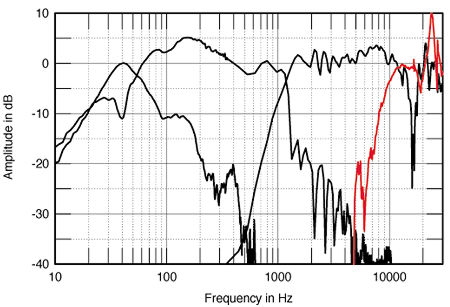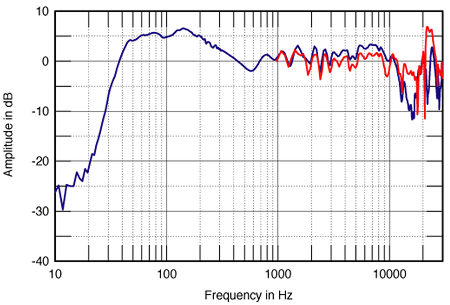| Columns Retired Columns & Blogs |
Tannoy Dimension TD12 loudspeaker Measurements
Sidebar 3: Measurements
Footnote 1: The foam stuffing has almost no effect on the woofer's level but lowers the ports' output by 3.7dB.—JA
Though the big Tannoy's voltage sensitivity was slightly lower than specified, at 90dB(B)/2.83V/m, this is still usefully higher than average. The impedance remains above 8 ohms for most of the audioband (fig.1), but drops to 2 ohms in the region covered by the SuperTweeter. In addition, the rather extreme electrical phase angle in the mid-treble—note the combination of 4.2 ohms and -51.8 degrees at 7.5kHz—will demand current from the partnering amplifier. Although there is generally not much musical energy above 5kHz, a good design rated at 4 ohms will still work best with the TD12.

Fig.1 Tannoy Dimension TD12, electrical impedance (solid) and phase (dashed). (2 ohms/vertical div.)
There is a peculiar discontinuity in the magnitude trace between 90Hz and 150Hz, as well as a much smaller glitch just below 300Hz. The latter coincides with the frequency of a mild panel resonance detectable on the rear panel (fig.2), but overall, the cabinet is quite inert for such a large speaker.

Fig.2 Tannoy Dimension TD12, cumulative spectral-decay plot calculated from the output of an accelerometer fastened to the cabinet's back panel. (MLS driving voltage to speaker, 7.55V; measurement bandwidth, 2kHz.)
The saddle at 36Hz in the impedance-magnitude trace defines the tuning frequency of the twin ports on the cabinet rear. However, both the minimum-motion frequency of the woofer and the corresponding peak in the port's output occur slightly higher in frequency, at 40Hz. (The impedance plot was taken with the resistive foam in place' the acoustic measurements were taken with the foam remmoved, footnote 1) This can be seen to the left of fig.3, as can slight discontinuities in both the woofer and port outputs in the region of the anomalous impedance behavior, probably due to some sort of internal air-space mode.

Fig.3 Tannoy Dimension TD12, acoustic crossover on coaxial tweeter axis at 50" (black), with nearfield responses of the woofer and ports plotted below 300Hz and 600Hz, respectively, and the SuperTweeter response at 12" (red).
Higher in frequency, the crossover between the two coincident drivers occurs at the specified 1.1kHz, with very steep rollout slopes evident, rather than the combination of first- and third-order slopes I was expecting from Tannoy's literature. The upside is that any treble breakup from that big ol' woofer cone is well-suppressed. The coincident tweeter is basically flat on-axis within its passband. However, there is a large suckout in the top octave, due to destructive interference between the tweeter and SuperTweeter at the 50" microphone distance on the tweeter axis. With two drivers handling the same frequency range but separated by several wavelengths, the speaker's radiation pattern in that region will be complex, with multiple peaks and nulls.
The red trace in fig.3 shows just the SuperTweeter's output; it rolls in pretty much as specified above 12kHz, with then a peak apparent between 20kHz and 30kHz. My measuring microphone is not calibrated above 30kHz, but it was clear that Tannoy's SuperTweeter is still going strong above that frequency.
The blue trace in fig.4 shows the response averaged across a 30 degrees horizontal window on the coincident tweeter axis at 50", spliced at 300Hz to the complex sum of the nearfield woofer and port responses. The first 3dB of the rise in the bass region will be due to the nearfield measurement technique, which assumes a 2pi or hemispherical environment, but the other 3dB is real. As AD found, the Dimension TD12 will have a generous low-frequency output in medium-sized rooms, but at the risk of sounding bass-heavy in small rooms. As implied by the impedance plot, the bass extension is only fair for such a large speaker, the -6dB point (ref. 100Hz) lying at the port tuning frequency of 36Hz. This will be extended in-room, of course, by the usual low-frequency "room gain."

Fig.4 Tannoy Dimension TD12, anechoic response on coaxial tweeter axis at 50", averaged across 30 degrees horizontal window and corrected for microphone response, with the complex sum of the nearfield responses plotted below 300Hz, taking into account acoustic phase and distance from the nominal farfield point (blue). Response at 50" on axis level with top of woofer shown in red.
To the right of fig.3, the blue trace is fairly flat from the upper midrange through to the bottom of the top octave, with then the interference suckout still evident. But as I said, the widely spaced tweeters lead to a complex dispersion pattern. Moving the mike up by 5" gives the red trace shown in fig.4, with a better balance evident between the mid- and high-treble regions.
All these acoustic measurements were performed with the grille removed. Repeating them with the grille in place resulted in a less evenly balanced treble, with peaks and dips of +2/-4dB evident compared with the blue trace in fig.4 (not shown). The grille looks gorgeous, but, like AD, I recommend using the speaker without it.
The benefit of Tannoy's traditional Dual-Concentric drive-unit topology is that the woofer's and tweeter's radiation patterns are much better matched through the crossover region than is usually the case with diaphragms of such different sizes. This can be seen in fig.5 as the evenness of the contour lines at all but extreme off-axis angles in the upper mids, where the 12" woofer can't help but become more directional.

Fig.5 Tannoy Dimension TD12, lateral response family at 50", normalized to response on coaxial tweeter axis, from back to front: differences in response 90 degrees-5 degrees off-axis, reference response, differences in response 5 degrees-90 degrees off-axis on driver side of baffle.
Note that the tweeter is more directional through its passband than is usually the case with a 1.25" dome. In normal-size rooms this will tend to compensate for the slightly hot on-axis treble. In large rooms, however, it will tend to make the sound too mellow, "dark," as AD described it. Above 10kHz, the "horns" to the sides of the reference response suggest that the on-axis interference suckout tends to fill in. But the ultrasonic SuperTweeter output otherwise falls off quite rapidly off-axis, which can also be seen in the vertical dispersion plot (fig.6).

Fig.6 Tannoy Dimension TD12, vertical response family at 50", normalized to response on axis level with top of woofer, from back to front: differences in response 15 degrees-5 degrees above axis, reference response, differences in response 5 degrees-15 degrees below axis.
The set-back nature of the Dual-Concentric drive-unit's tweeter can result in time-coherent performance, though this will also be affected by the characteristics of the crossover. The TD12's step response on the tweeter axis (fig.7) does superficially appear time-coherent, but note the sharp downward spike about 400µs after the initial rise away from the time line. Ignore the reflection at 6.3ms, which is due to the first ground reflection; the speaker was unfortunately too bulky for me to lift off the floor and onto a stand for the acoustic measurements. However, the reflection at the 5ms mark is a characteristic of the speaker, possibly the tweeter output reflecting and/or diffracting from the edge of the woofer cone.

Fig.7 Tannoy Dimension TD12, step response on coaxial tweeter axis at 50" (5ms time window, 30kHz bandwidth).
To examine the TD12's time-domain performance in more detail, fig.8 shows the individual step responses of the woofer (red trace) and tweeter-SuperTweeter (blue). The tweeter can be seen to be connected in inverted polarity to the woofer; though not visible in this graph, the SuperTweeter is connected in positive polarity. The reflection mentioned above is actually apparent in the woofer trace, not that of the tweeter. I have no idea what its cause is.

Fig.8 Tannoy Dimension TD12, step response of woofer (red) and tweeters (blue) on coaxial tweeter axis at 50" (5ms time window, 30kHz bandwidth).
Because I could not raise the speaker much off the ground for the measurements, when I plotted the Tannoy's cumulative spectral-decay graph (fig.9) I had to drastically window the impulse-response data to keep the first ground reflection from corrupting the data. Even so, the various internal reflections and double arrivals noted above make the plot look more hashy than is possibly the case, particularly in the region covered by the SuperTweeter. Ignoring that behavior, it looks as if the TD12's initial decay is actually pretty clean.—John Atkinson

Fig.9 Tannoy Dimension TD12, cumulative spectral-decay plot at 50" (0.15ms risetime).
Footnote 1: The foam stuffing has almost no effect on the woofer's level but lowers the ports' output by 3.7dB.—JA
- Log in or register to post comments




































